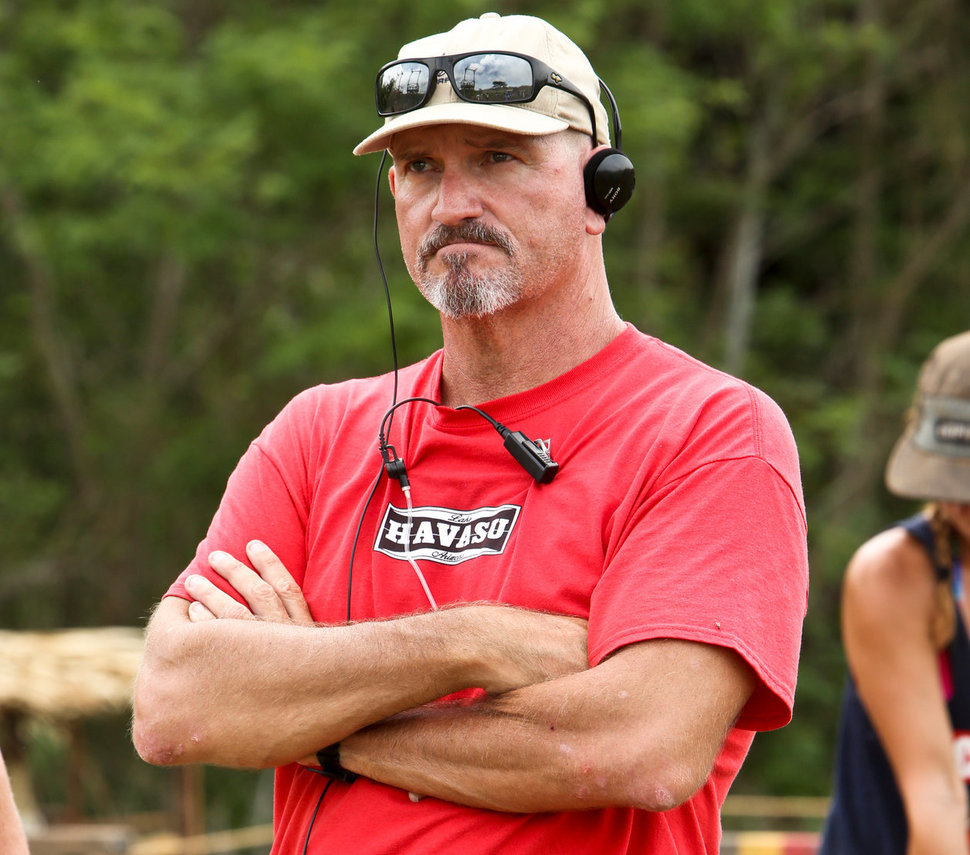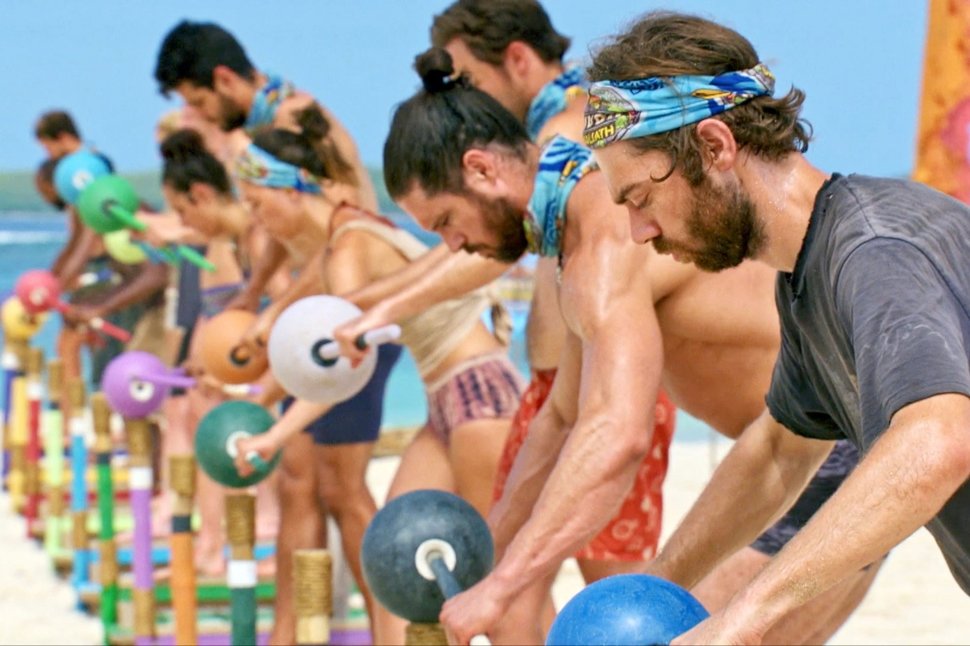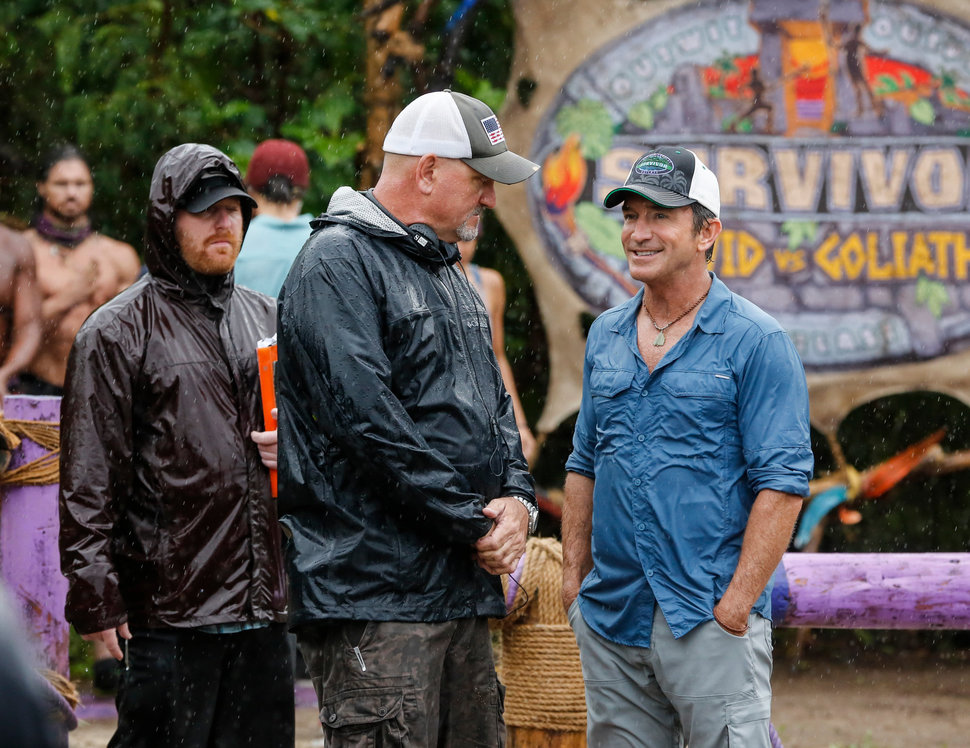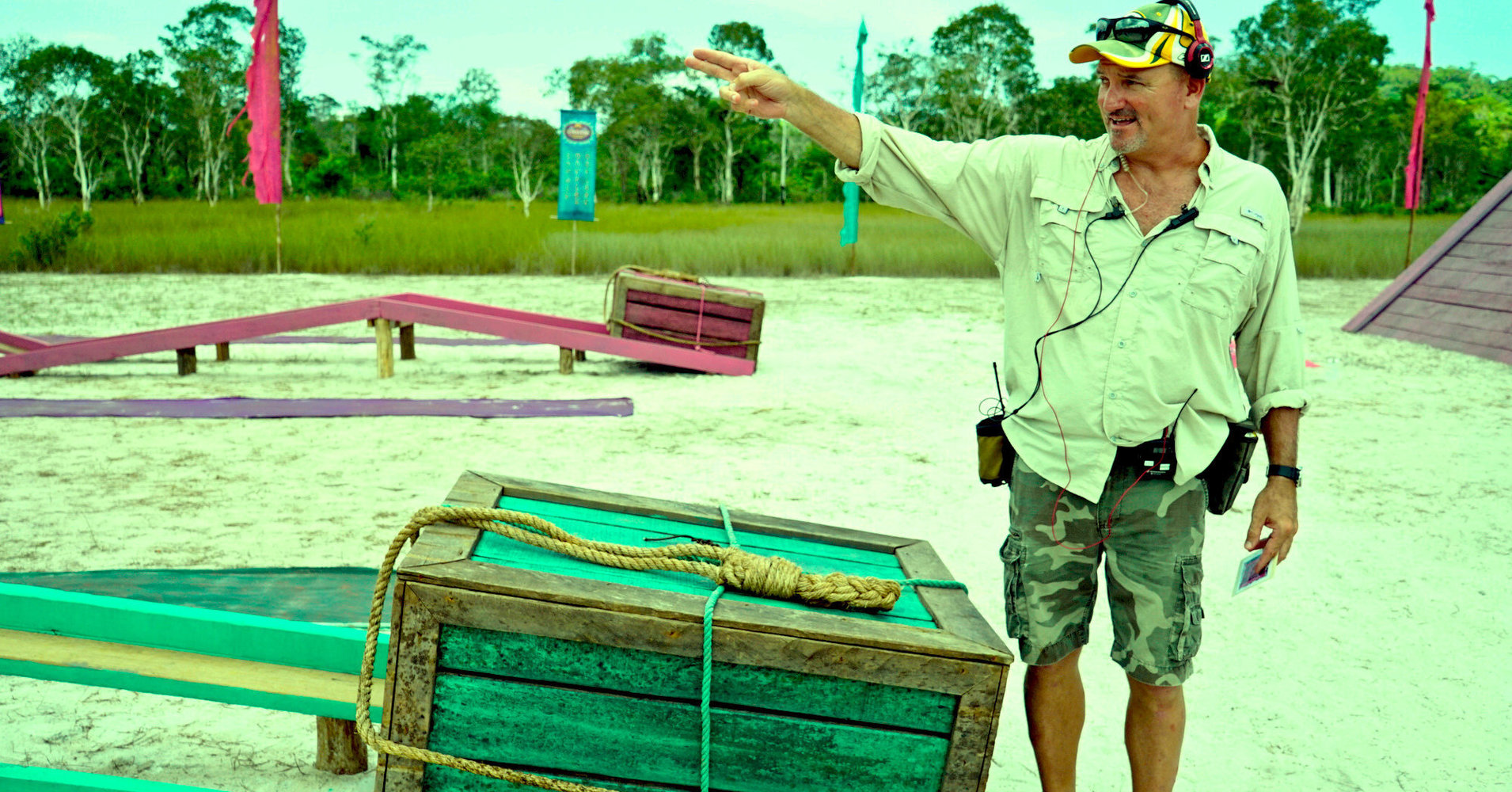[ad_1]
On some isolated island, members of a marooned group of reality TV stars are strapped to two large windmill contraptions resting on a platform over tanks of water. On the platform stand their spirited teammates, who are eagerly spinning the machine’s wheels, submerging their tied-up friends for enough time for them to slurp up giant mouthfuls of water. The captives must spit out the water from their mouths into tubes, which, once full, will release a ball. Why are they consenting to this? you might ask. Well, they’re desperate to complete the bizarre Rube Goldberg scenario so they can move onto solving the puzzle portion of the task, for it’s the key to immunity in the next tribal council.
Of course! They’re “Survivor” contestants, and it’s challenge time.
This particular challenge doesn’t just sound dangerous, it is “unequivocally the most dangerous one” the beloved CBS show has ever featured, longtime game maker John Kirhoffer told HuffPost in a lengthy interview last month. The evil baseball cap-wearing genius has been producing reward and immunity challenges for “Survivor” since the show’s inception in 2000, concocting gross, puzzling and, yes, dangerous concepts for its nearly 40 seasons.
“I’m only 22 years old, but if you look at me now I look 56 because I aged so much during that challenge,” he joked. “I was so nervous the whole time. We had people on the side, our safety team and our security, but, man, I was very concerned with that one. It worked great in ‘Nicaragua’ [Season 21] and again in ‘Redemption Island’ [Season 22], but we’ve never done it again just because my hair’s gray enough.”
Yet here he is, 38 seasons in, still coming up with bizarre challenges like reality TV’s version of The Hunger Games’ Seneca Crane. And he shows no signs of stopping.

And why would he? “Survivor,” despite a predictable dip in viewership over the last two decades, is still a ratings stalwart for CBS, often winning its Wednesday night time slot battles over ABC, Fox and NBC. An average of 7.3 million viewers tuned in for Season 37, “David vs. Goliath,” which wrapped late last year. That may be a paltry showing compared with the series’ incredible high of 30 million average viewers for Season 2. Still, the 38th season, “Edge of Extinction,” debuted to steady ratings last week.
The basic premise of “Survivor” ― a group of 16 to 20 castaways is sent to a remote island, split into tribes and left to “outwit, outplay and outlast” each other for 39 days until a winner is crowned ― hasn’t changed much, making Kirhoffer’s job relatively easy. His apparently infinite well of twisted ideas gives host and producer Jeff Probst a loyal audience to entertain year after year.
Probst might be the face of the enterprise, but Kirhoffer is the competitive brains. He’s the guy who makes contestants endure water torture, who makes them chew and swallow squirming bugs, who orchestrates blindfolded mazes and pain-inducing pole hugs. All for the sake of good TV.
As “Edge of Extinction” airs, Kirhoffer ― who just might be one of the kindest, most jovial people I’ve ever interviewed ― agreed to walk us through his job, from the start of a new “Survivor” season to a typical finale challenge brainstorm, and discuss how he consistently ups the ante of a decades-old competition show. Here’s what the game maker had to say about his violent version of basketball, eating slugs, Probst’s castle and upcoming “Survivor” seasons:

Setting The Course In A California Conference Room
Every season of “Survivor” starts somewhere. For Kirhoffer, that somewhere happens to be a conference room in Los Angeles.
In contrast to the far-flung locales of past seasons (from Kenya, Borneo, Cambodia and Palau to, for the past six “Survivor” iterations, the Mamanuca Islands of Fiji), the primary phase of Kirhoffer’s work takes place in that office. About three months before the show starts filming in March of each year, Mark Burnett Productions reveals where the next troupe of willing reality TV actors will descend. Kirhoffer and his team travel to the locale for some initial research, but then it’s back to the conference room to start planning.
“We go out and do a scout to see what kind of landscape we have,” Kirhoffer said. “Do we have big fields? Do we have rolling hills? Do we have flat water? Do we have waves? What kind of water clarity is there? Then, we come back to the States and we start putting together our challenges.”
Kirhoffer is usually responsible for two challenges per hourlong episode: one delivers a tangible reward to its winners (e.g. flint for fire, utensils for cooking, tarp for shelter, notes from loved ones) and the other grants immunity (meaning the winning contestant or team can’t be voted off the island by their peers at the next tribal council). That means Kirhoffer and company are coming up with 30 some-odd challenges every season, each one an attempt to outshine the obstacle course preceding it.
Although he reuses some challenges that have been successful in the past (“Blind Leading the Blind,” “Get a Grip” or “The Ball Drop”), Kirhoffer said it takes his team weeks to concoct and plan the newer games before ideas are delivered to the art department, which constructs each obstacle course or puzzle on site. Typically, the department works with a minimal set of previously used materials, but shipping is expensive. So most of the challenges in Fiji, for example, are built from scratch using imported timber and materials from Australia or New Zealand.
Kirhoffer’s right-hand man and producer Chris Marchand prefers the wacky new pitches, like “Blind Barrow,” in which one member from each tribe would sit on a wheelbarrow, directing two blindfolded members as they push him or her through a series of obstacles. The experience of watching the art department develop mazes and “Flinstoney” type carts from start to finish is delightful for Marchand. “Every day’s a new adventure,” he said. “You never know what you’re going to get into, and we try to get some crazy stuff through the arts department.”
Kirhoffer agreed. Referring to well-known past “Survivor” participants, he said, “While it’s fun to watch and say, ‘Oh I remember when Boston Rob did that’ or ‘I remember when Ozzy did that,’ we need to create new ideas so that they can become classics and we can start repeating them down the road.”
Enter: The Dream Team
At this point, the cast has come together after a six-month production search. Until shooting begins, changes to the season’s “competitive but fair” challenges, as Kirhoffer describes them, will occur constantly. Eventually he and his coworkers will make the trek to Fiji or elsewhere to be on set before filming begins. And that’s where the Dream Team comes in.
These lucky hirees test Kirhoffer’s designs for him, running the courses on site before the castaways get a chance. They’re the first to, say, team up in groups of four to carry a very heavy bag of coconuts over various sea and land obstacles. If any part of the task seems utterly impossible or a little too easy, Kirhoffer and his team will tweak the course.
The young men and women are not contestants, but production assistant crew members who are hired by Kirhoffer to do tasks ranging from painting sets to helping with camera or lighting tests. Most of the time these youngsters have a connection to someone on the production team, or do outlandish things ― like create videos, send letters to former contestants or relentlessly message Probst ― to get a job offer.
“What we do is hire 11 at least 21-year-old people and they live with us on the island,” Marchand said. “They rehearse every game to make sure it is fair, competitive and fun to watch, and they help us with figuring out all those little bits and pieces that we need to adjust.”
These “crash-test dummies,” as one former Dream Teamer described them, also have to try the local delicacies Kirhoffer picks for food challenges, like cow brain or beetle larva. “They’re not all that enthusiastic about rehearsal that day,” Kirhoffer said. “They’re out there like, ‘Oh my gosh, I don’t want to eat a slug or a cockroach!’ So Jeff will just ante it up and say, ‘OK, you’ll get a day off from work and a massage voucher.’ And then they feel it’s worth playing for.”
“Beer is a big motivator for the Dream Team,” Probst joked in a behind-the-scenes video from 2010.
It all pays off in the end. Even though they don’t end up on the show as contestants, dedicated Dream Teamers have been known to procure full-time positions on the crew. “On location, at any point, we have up to 35 former Dream Teamers,” Kirhoffer said. “And right now we have seven in our office. So it is a pretty cool opportunity if you can get it.”
About Those Food Challenges
As for those classic “Survivor” challenges that force contestants to ingest food less palatable to tepid Western tastebuds, some fans may have noticed that they haven’t been featured on the show much over the last few years. These days, Kirhoffer said, he prefers to make challenges that feel “indigenous” to the filming location, rather than depict culinary scenarios meant to gross out American audiences with potentially xenophobic portrayals of foreign food.
“We started with Season 1 [saying], ‘Here’s something that the locals eat as a delicacy. This is what local people survive on.’ And then when ‘Fear Factor’ got ahold of it, they went, ‘Here’s something that won’t kill you if you eat it,’ so it became more about that,” Kirhoffer said. “The closest to the edge that we got of not quite what the locals do was our ‘Survivor’ smoothies, where we’d take a whole bunch of things that they do eat and put them in a blender and have (the show’s contestants) drink it down.”
Another culinary-adjacent challenge is known as the “Survivor Auction,” in which Probst gives the castaways upward of $500 each to bid on a variety of things from peanut butter to french fries to dead bats. (You can guess which is least popular.) Sometimes Probst announces the food in advance, other times he keeps items covered, hinting that it is more than grub he is auctioning off. It’s always been a fan-favorite “challenge,” in which competitors either spend their money on delectable sustenance or hoard their cash for strategic advantages ― immunity idols, head starts in challenges, etc. Once the auction is over, their money is deemed useless.
However, “Survivor Auction” hasn’t made an appearance on the show in a while, because apparently Probst thinks it’s boring. “David vs. Goliath” player Christian Hubicki revealed to The Hollywood Reporter last year that the longtime host told him the auction “will not come back.” “His reasoning was that it’s not as interesting to watch hungry people eat food anymore,” Hubicki said.
“The game has shifted to be more strategic,” Kirhoffer explained to HuffPost. “Everything you see ― every challenge, every reward ― there’s an advantage hidden somewhere, usually. There’s a potential for strategy. So the auction just became about people saving their money, waiting for the advantage. We love the auction, though. There’s a very good chance you’ll see it in the next few years.”
Injuries, Health Scares, Dehydration, Oh My!
When survivors aren’t swallowing slimy sea slugs or bidding on advantages, they’re competing in tough physical challenges that test not only their strength but inner will: hoisting sandbags over various barriers, diving underwater to collect keys to unlock puzzle pieces, sumo wrestling their competitors. Some of these games end up being a little more dangerous than Kirhoffer expected; injuries and dehydration do occur.
“Sometimes, our young people who test them do much better than the contestants because they’re well-fed, they got a good night’s sleep, they’re fit,” Kirhoffer said of the Dream Teamers. “But then sometimes they don’t do even close to what the contestants do because they don’t have pride or a million dollars on the line. They’re not competing in the show they’ve dreamed about their entire lives.”
According to Kirhoffer, the safety of all those involved is paramount, but some of the more physically grueling challenges have spurred health scares. “Schmergen Bowl,” for instance, is perhaps the most physically demanding of all “Survivor” challenges. It’s a form of basketball where castaways are able to push and shove one another in a pit while tossing balls to their teammates to shoot and score.
Despite Probst telling Season 19 contestants not to throw out “anything resembling a cheap shot,” player Ben Browning was disqualified after he aggressively tripped competitor Russell Swan. And Mike Borassi, the oldest member on that season, was evacuated after becoming disoriented and weak.
When the challenge was resurrected for Season 20, James Clement, one of the strongest contestants to ever play “Survivor,” suffered a terrible knee injury that continued to affect him post-show.
And then there was “Battle Dig,” which also took place on Season 20, “Heroes vs. Villains.” Basically, two members from each tribe had to run out to a designated area and dig up a heavy bag in the sand. Whoever found the bag first was then attacked by the opposing team’s tribe members, who would do anything to pry it from their hands before they reached the finish line.
“Stephenie [LaGrossa] dislocated her shoulder, Rupert [Boneham] broke his toe, Coach [Wade] rode Colby [Donaldson] like a pony, Sugar [Kiper] lost her top,” Kirhoffer said.
Partly due to situations like this, the game maker had to scale back.
“When we’re designing, as corny as it sounds, safety comes first,” Kirhoffer said. “We want things to be exciting, but these aren’t elite athletes. It’s not ‘Ninja Warrior’ or ‘Titan Games’ where you have these elite athletes who you can ask more of,” he said. “We’re very, very aware that there’s housewives and business guys who aren’t that physically fit [on our show]. They pass their physicals and all that stuff, but whenever there’s something that’s too sketchy, we pretty much avoid it.”
Marchand also noted that the environment these players compete in adds to the overall risk of the challenges.
“It can and does get super dangerous when it is hot and they are lacking food and hydration,” he said. “But they’re always well looked after and we make sure that everyone is safe as can be. And if something happens to go wrong, our medical team is in there and the challenge is no longer their priority.”
The Allure Of ‘Uncomfortably Numb’ And Other Cerebral Triumphs
“There was a time we were doing a lot of really, really aggressive challenges,” Kirhoffer said. “One of the things we started thinking was, we should try to peel back from that so nerdier people or older people, maybe, who are great characters, don’t become targets right away.”
As a result, most of the more recent “Survivor” challenge courses involve puzzles, which Kirhoffer believes produce an even playing field for all players, whether they’re athletes or scientists.
“It was actually [executive producer] Mark Burnett who said, ‘Whoever crosses the finish line, now let’s have a test of skill or a puzzle,’” Kirhoffer said. “Because one of the most satisfying things is the come-from-behind victory. Somebody succeeded with their brawn, and then the brains came back and won it.”
Tests of endurance, however, are still a game maker favorite. These mind-over-matter challenges tend to reward winners with immunity and often require contestants to partake in less outright physical tasks, like balancing on their toes or supporting their full weight on thin footholds or hanging from a bar above the water using only their legs.
On Season 37, self-proclaimed nerd and robotics scientist Hubicki outlasted his competitors in a challenge called “Uncomfortably Numb,” in which players had to balance on a very narrow perch while holding a handle behind their head. After five-and-a-half hours of position changing and eye-rolling, he beat out bartender Alec Merlino, proving a David can certainly defeat a Goliath in a test of who wants it more.
“You just don’t know how long someone’s going to go,” Kirhoffer said. “And in a challenge like ‘Uncomfortably Numb,’ anybody can win. You don’t have to be an elite athlete or a cerebral superstar. You just have to dig deep and want it.”
Where’s Jeff Probst? In His Castle, Of Course
So, at this point, we know what Kirhoffer and his team are busy doing every day, we know how the Dream Teamers factor in, and we’re very familiar with what the castaways are required to endure before, during and after challenges. But what does Jeff Probst do all day? Does he live in a beat-up bamboo shelter, too?
Given that we had Kirhoffer on the phone, we had to ask.
“He has a castle, it’s in his contract,” Kirhoffer joked.
Yes, Probst does have his own house in Fiji, but when he’s there, he’s usually thinking about how to better the “Survivor” franchise, which he “runs, manages, is the face of, and the creative vision of,” according to Burnett.
Kirhoffer said Probst’s “got big whiteboards in his living room and he’s constantly working on things.” One board is for random idea generation, the other for episodic structure.
“A lot of our format is worked out ― we know we have challenges ― but any time we’re doing a unique season, we usually bring something unique to it,” Probst told Todd Garner on “The Producer’s Guide” podcast. “That’s the stuff we’re trying to plot out.”
While Probst brainstorms in his quarters, the rest of the crew takes over a resort where they enjoy catering by head chef Mary Anne Houston and comfortable beds. “You can’t expect us to be living in a hammock between two trees [like the contestants],” Kirhoffer said. “We’re going seven days a week, dusk to past dawn every day.”
It’s the same sort of schedule for Probst.
“Jeff is at every test, every rehearsal,” Kirhoffer said. “He’s not shy to let us know, ‘You know, that’s kind of lame, wouldn’t it be better if they did this?’ Or ‘Should it be a little more physical?’ Or ‘I think it’s a little too physical.’ I’m not just trying to blow smoke up my boss’s back alley, but he owns it. He owns the show.”
Just like Kirhoffer keeps the challenges rolling year after year, Probst keeps the viewers tuning in. When one season ends, a new one immediately begins ― at least in Probst’s eyes. The job is never done.
″‘David vs. Goliath’ will have ended, he’s just poured his blood, sweat and tears into rehearsing and everything for weeks, and it’s over and we’re popping our first beers saying, ‘Woo! What a great finale, so glad so-and-so won!’ And all the sudden there’s a text,” Kirhoffer said, ”‘Hey guys, next season let’s remember to do this, this and this. Let’s get a list of this, this, and this.’ We’re like, ‘Oh my God, dude. Shut down and have a glass of wine or something and chill!’”

And The Cycle Begins Again
Right now, Probst and the rest of the production team are shooting Seasons 39 and 40 (seasons are usually shot back-to-back), which will air in the fall of 2019 and winter of 2020, respectively. The franchise that gave us Richard Hatch, Boston Rob, Parvarti Shallow and Sandra Diaz-Twine is still kicking, almost 20 years after it helped spark the reality TV genre. Even back then, Kirhoffer knew he’d struck gold.
“Season 1, I was offshore on a boat with Mark Burnett and he said to me, ‘John, this is going to be the biggest show in the world, and you and I are going to be working together for a long, long time,’” Kirhoffer said. “And I was like, ‘From your lips to God’s ears, Mark. That would be great.’ And this is our 20th year doing this show together.”
“We spend more than half our lives on location, out of the country, and we’re a family,” he concluded. “For me personally, you don’t get those homesick pains of isolation because so much of our crew has been there for so many years. Right down to Jeff. It’s just a friendly, loving, nurturing environment, which I think is a key reason we’re still chugging along.”
“Survivor” airs Wednesdays at 8 p.m. on CBS.
[ad_2]
Source link

